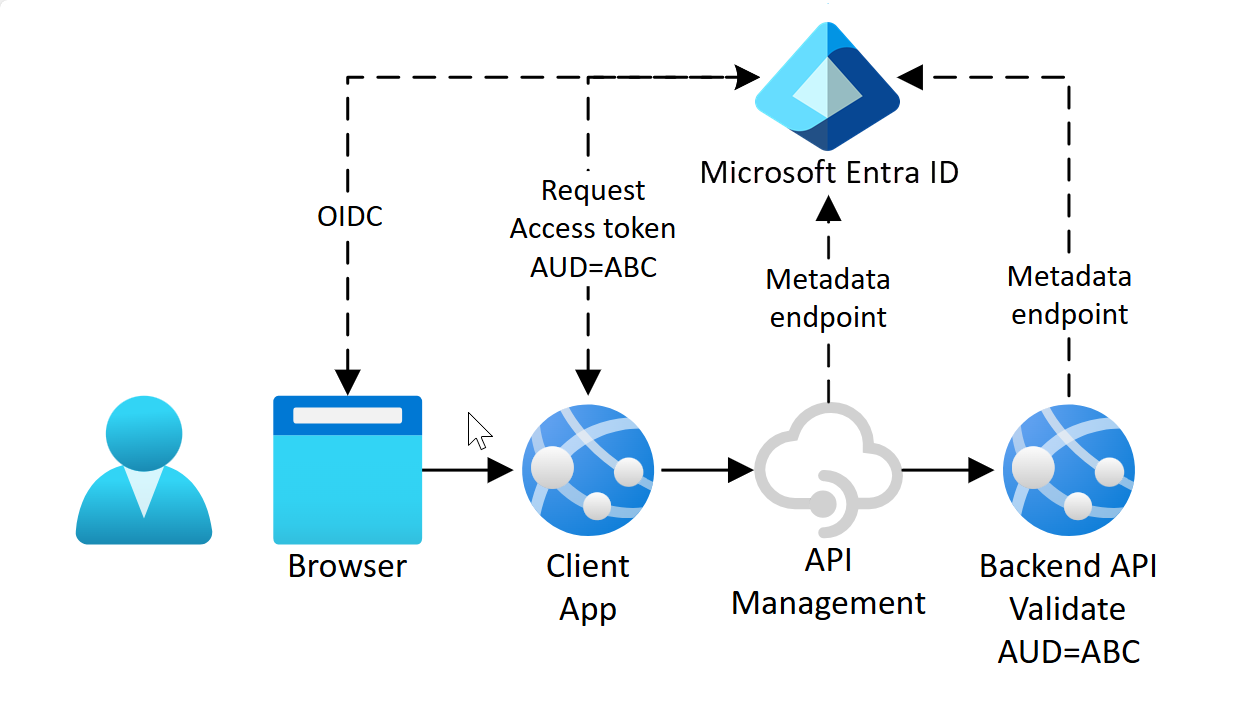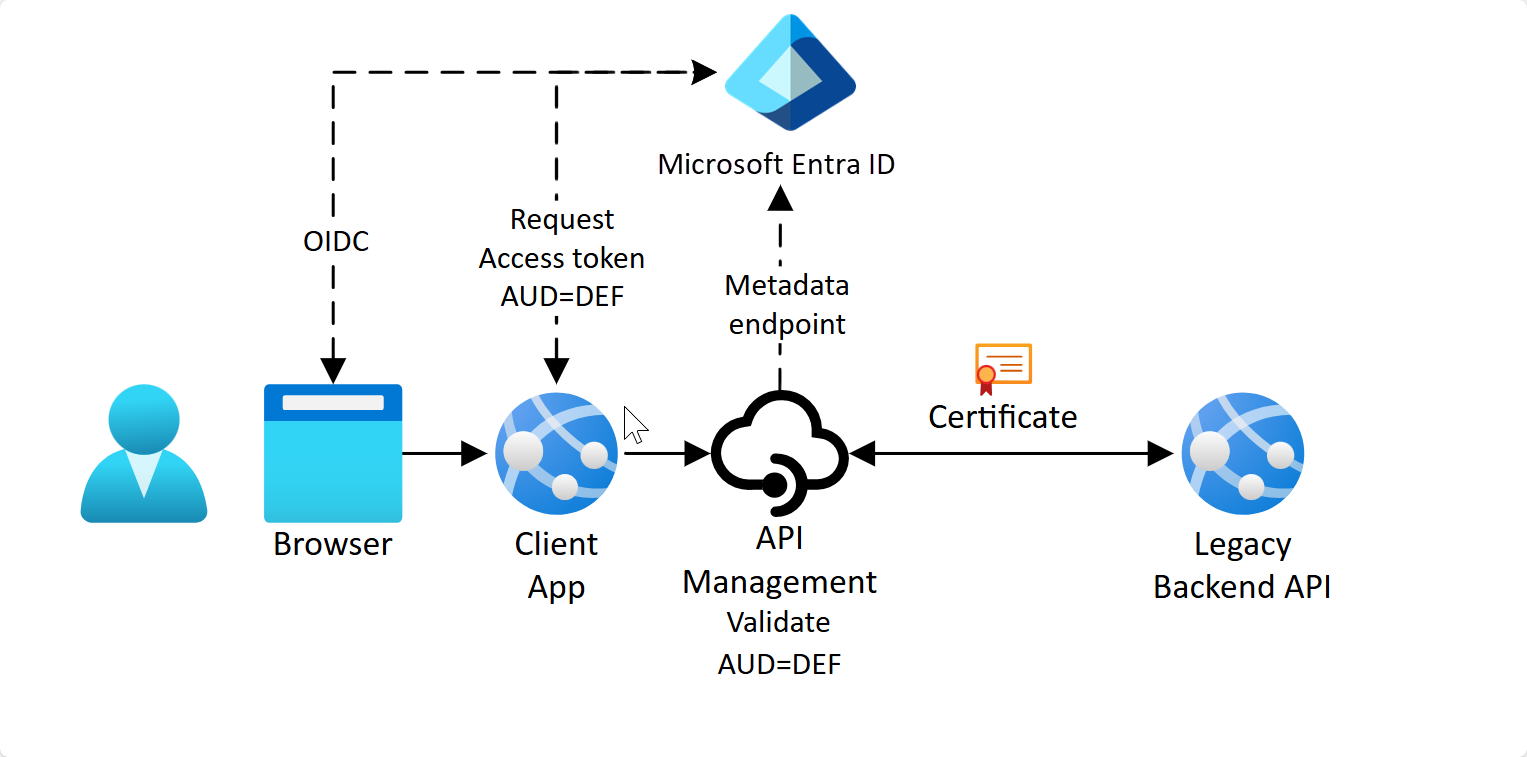Note
Access to this page requires authorization. You can try signing in or changing directories.
Access to this page requires authorization. You can try changing directories.
APPLIES TO: All API Management tiers
This article is an introduction to a rich, flexible set of features in API Management that help you secure users' access to managed APIs.
API authentication and authorization in API Management involve securing the end-to-end communication of client apps to the API Management gateway and through to backend APIs. In many customer environments, OAuth 2.0 is the preferred API authorization protocol. API Management supports OAuth 2.0 authorization between the client and the API Management gateway, between the gateway and the backend API, or both independently.
API Management supports other client-side and service-side authentication and authorization mechanisms that supplement OAuth 2.0 or that are useful when OAuth 2.0 authorization for APIs isn't possible. How you choose from among these options depends on the maturity of your organization's API environment, your security and compliance requirements, and your organization's approach to mitigating common API threats.
Important
Securing users' access to APIs is one of many considerations for securing your API Management environment. For more information, see Azure security baseline for API Management.
Note
Other API Management components have separate mechanisms to secure and restrict user access:
- For managing the API Management instance through the Azure control plane, API Management relies on Microsoft Entra ID and Azure role-based access control (RBAC).
- The API Management developer portal supports several options to facilitate secure user sign-up and sign-in.
Authentication versus authorization
Here's a brief explanation of authentication and authorization in the context of access to APIs:
Authentication: The process of verifying the identity of a user or app that accesses the API. Authentication can be done through credentials such as username and password, a certificate, or through single sign-on (SSO) or other methods.
Authorization: The process of determining whether a user or app has permission to access a particular API, often through a token-based protocol such as OAuth 2.0.
Note
To supplement authentication and authorization, you should also secure access to APIs using TLS to protect the credentials or tokens you use for authentication or authorization.
OAuth 2.0 concepts
OAuth 2.0 is a standard authorization framework that's widely used to secure access to resources such as web APIs. OAuth 2.0 restricts actions of what a client app can perform on resources on behalf of the user, without ever sharing the user's credentials. While OAuth 2.0 isn't an authentication protocol, it's often used with OpenID Connect (OIDC), which extends OAuth 2.0 by providing user authentication and SSO functionality.
OAuth flow
What happens when a client app calls an API with a request that's secured using TLS and OAuth 2.0? The following is an abbreviated example flow:
The client (the calling app, or bearer) authenticates using credentials to an identity provider.
The client obtains a time-limited access token (a JSON web token, or JWT) from the identity provider's authorization server.
The identity provider (for example, Microsoft Entra ID) is the token issuer, and the token includes an audience claim that authorizes access to a resource server (for example, to a backend API or to the API Management gateway itself).
The client calls the API and presents the access token; for example, in an Authorization header.
The resource server validates the access token. Validation is a complex process that includes a check that the issuer and audience claims contain expected values.
Based on token validation criteria, access to resources of the backend API is then granted.
Depending on the type of client app and scenarios, different authorization flows are needed to request and manage tokens. For example, the authorization code flow and grant type are commonly used in apps that call web APIs. Learn more about OAuth flows and application scenarios in Microsoft Entra ID.
OAuth 2.0 authorization scenarios in API Management
Scenario 1 - Client app authorizes directly to backend
A common authorization scenario is when the calling application requests access to the backend API directly and presents an OAuth 2.0 token in an authorization header to the gateway. Azure API Management then acts as a "transparent" proxy between the caller and backend API and passes the token through unchanged to the backend. The access token's scope is between the calling application and backend API.
The following image shows an example where Microsoft Entra ID is the authorization provider. The client app might be a single-page application (SPA).

Although the access token sent along with the HTTP request is intended for the backend API, API Management still allows for a defense in depth approach. For example, configure policies to validate the JWT, rejecting requests that arrive without a token or a token that's not valid for the intended backend API. You can also configure API Management to check other claims of interest extracted from the token.
Note
If you secure an API exposed through Azure API Management with OAuth 2.0 in this way, you can configure API Management to generate a valid token for test purposes on behalf of an Azure portal or developer portal test console user. You need to add an OAuth 2.0 server to your API Management instance and enable OAuth 2.0 authorization settings in the API. For more information, see How to authorize test console of developer portal by configuring OAuth 2.0 user authorization.
Example:
Tip
In the special case when API access is protected using Microsoft Entra ID, you can configure the validate-azure-ad-token policy for token validation.
Scenario 2 - Client app authorizes to API Management
In this scenario, the API Management service acts on behalf of the API, and the calling application requests access to the API Management instance. The scope of the access token is between the calling application and the API Management gateway. In API Management, configure a policy (validate-jwt or validate-azure-ad-token) to validate the token before the gateway passes the request to the backend. A separate mechanism typically secures the connection between the gateway and the backend API.
In the following example, Microsoft Entra ID is again the authorization provider, and mutual TLS (mTLS) authentication secures the connection between the gateway and the backend.

There are different reasons for doing this. For example:
The backend is a legacy API that can't be updated to support OAuth
You should first configure API Management to validate the token (checking the issuer and audience claims at a minimum). After validation, use one of several options available to secure onward connections from API Management, such as mutual TLS (mTLS) authentication. See Service side options later in this article.
The context required by the backend isn't possible to establish from the caller
After API Management has successfully validated the token received from the caller, it then needs to obtain an access token for the backend API using its own context or context derived from the calling application. This scenario can be accomplished using either:
A custom policy such as send-request to obtain an onward access token valid for the backend API from a configured identity provider.
The API Management instance's own identity, passing the token from the API Management resource's system-assigned or user-assigned managed identity to the backend API.
The organization wants to adopt a standardized authorization approach
Regardless of the authentication and authorization mechanisms on their API backends, organizations can choose to converge on OAuth 2.0 for a standardized authorization approach on the front end. API Management's gateway can enable consistent authorization configuration and a common experience for API consumers as the organization's backends evolve.
Other options to secure APIs
Although authorization is preferred and OAuth 2.0 has become the dominant method of enabling strong authorization for APIs, API Management provides several other mechanisms to secure or restrict access between client and gateway (client side) or between gateway and backend (service side). Depending on the organization's requirements, you can use these to supplement OAuth 2.0. Alternatively, configure them independently if the calling applications or backend APIs are legacy or don't yet support OAuth 2.0.
Client side options
| Mechanism | Description | Considerations |
|---|---|---|
| mTLS | Validate certificate presented by the connecting client and check certificate properties against a certificate managed in API Management | Certificate can be stored in a key vault. |
| Restrict caller IPs | Filter (allow/deny) calls from specific IP addresses or address ranges. | Use to restrict access to certain users or organizations, or to traffic from upstream services. |
| Subscription key | Limit access to one or more APIs based on an API Management subscription | We recommend using a subscription (API) key in addition to another method of authentication or authorization. On its own, a subscription key isn't a strong form of authentication, but using the subscription key might be useful in certain scenarios; for example, tracking individual customers' API usage or granting access to specific API products. |
Tip
For defense in depth, we strongly recommend deploying a web application firewall upstream of the API Management instance. For example, use Azure Application Gateway.
Service side options
| Mechanism | Description | Considerations |
|---|---|---|
| Managed identity authentication | Authenticate to backend API with a system-assigned or user-assigned managed identity. | Recommended for scoped access to a protected backend resource by obtaining a token from Microsoft Entra ID. |
| Certificate authentication | Authenticate to backend API using a client certificate. | Certificate can be stored in key vault. |
| Basic authentication | Authenticate to backend API with username and password that are passed through an Authorization header. | Discouraged if more secure authentication options are available (for example, managed identity, certificates, credential manager). If chosen, use named values to provide credentials, with secrets protected in a key vault. |
Related content
- Learn more about authentication and authorization in the Microsoft identity platform.
- Learn how to mitigate OWASP API security threats using API Management.